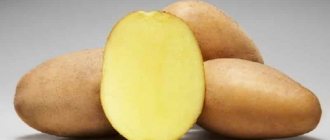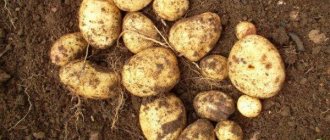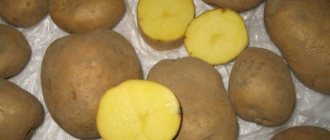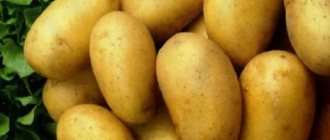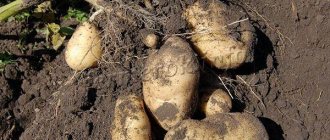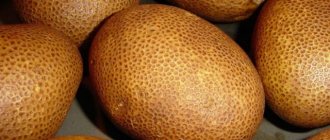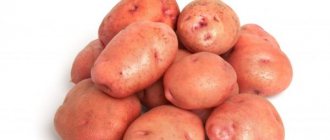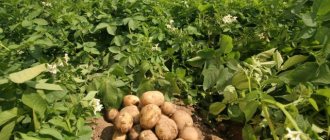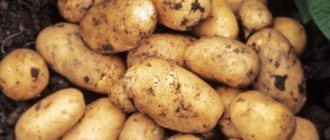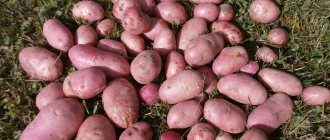Description and characteristics of potato varieties in Belarus
Potatoes developed by Belarusian breeders are intended for cultivation in this country. It is grown for agricultural purposes: sold, left for feeding animals, and processed into semi-finished products. Also, many species from Belarus are in demand among gardeners in many countries and regions.
Early, middle and late types according to ripening period have been developed. Many of them tolerate dry periods and spring frosts well. Belarusian potatoes are easy to care for and produce a large harvest.
Important! The later the variety, the higher its resistance to infections.
Video about the variety “Krinitsa”
Unfortunately, there is no video for this variety at the moment. We invite you to watch the video section of our website, where other videos about potatoes and other agricultural crops are posted. We and the entire farming community will be grateful if you send us your video or link about this variety from YouTube or any other video hosting service. If you see this message, it means that we have not yet been able to find a suitable video for this variety.
Similar articles:
Potatoes and all their varieties in detail here → Potato variety “Bryansk New” - description characteristics reviews photo video
Potatoes and all its varieties in detail here → Potato variety "Brook" - description characteristics reviews photo video
Potatoes and all their varieties in detail here → Potato variety “Batya” - description characteristics reviews photos video
Potatoes and all their varieties in detail here → Potato variety “Bronnitsky” - description characteristics reviews photos video
Potatoes and all their varieties in detail here → Potato variety “Bonnie” - description characteristics reviews photos video
Early potato varieties of Belarusian selection
Early ripening potatoes fully ripen 75-85 days after being transferred to the ground. In the southern regions they can be grown twice per season.
Uladar
They are often planted in their gardens. The fruits are characterized by medium digestibility. One bush produces 11-13 tubers. Potatoes are medium size, skin color is yellow-brown. The pulp is dense, light yellow.
Aksamit
Medium-yielding species, produces 10-15 root crops per bush. The surface of the fruit is brown, the inside of the fruit is light yellow. Average starch content. Cookability is good. Has good taste.
Dolphin
Dolphin produces potatoes with thin brown skin and a light yellow color when cut. The shape of the fruit is round and elongated. 15-17 tubers are dug from one plant. The dolphin has strong immunity. Retains moisture in dry climates.
Lapis lazuli
Produces large fruits covered with a brown shell. When cut, the tubers are light yellow in color. It tastes good. Ultra early variety. Harvesting occurs 65-75 days after sowing. Is immune to potato cancer. The fruits are stored in a cool place with a temperature of 2-4 °C, protected from the sun.
Late ripening varieties
Tubers ripen on the 124-133rd day of the growing season. These varieties have strong immunity.
Produces medium and large fruits. They are covered with thin skin of light brown color. In cross section, the root crop is light yellow. Stonefly exhibits good keeping quality, immunity to infections and resistance to dry periods.
Tall bushes are developing. The fruits are large, light brown in color. The pulp is bright yellow, dense. Does not lose its shape when cooked. The peculiarity of the variety is that it can be dug up unripe. Rogneda exhibits good keeping quality, the fruits retain their shape without changes until the beginning of the next season.
Mid-early potatoes
Mid-early potatoes allow you to harvest root crops 92-100 days after being placed in the ground. These varieties have an average shelf life and high yield.
Lily
Lily produces medium-sized tubers with an elongated oval shape. The skin is light brown and forms a small number of shallow eyes. The pulp is dense, yellow. Liley potatoes are used for freezing and deep-frying. The pulp does not boil over and retains its shape.
A high-yielding species, produces 10-13 tubers per plant. With regular fertilizing, the amount of harvest can be increased. The fruits are medium-sized with light brown skin; when cut, the potatoes are white with a yellow tint. Yanka tolerates prolonged drought well and is resistant to spring frosts.
Mid-season varieties
Mid-season varieties of potatoes produce a harvest 100-105 days after sowing.
Dubrava
Oak grove is resistant to potato diseases: scab and potato cancer. It has round fruits of bright yellow color. The yield is 50 tons per hectare. The pulp is cream-colored, which indicates a high starch content in the tubers. The fruits fall apart when cooked.
Krinitsa
Krinitsa tubers are yellow-brown in color. The shape of the tubers is round and elongated. The variety is resistant to scab, nematode and cancer. The average yield is 49.5 tons per hectare.
The pulp is light creamy in color. The taste is good. Potatoes are grown for industrial purposes and on their own plots.
Volat
Volat is immune to scab, cancer and nematode. Produces fruits covered with yellow skin. The shape of the fruit is round or oval. Light yellow in cross section. Contains about 17-20% starch. Productivity is high; 65 tons of potatoes are harvested from one hectare of land.
Belarusian potato varieties: Kolorit, Krinitsa, Lad, Rosinka, Skarb, Talisman and Universal
Kolorit is a mid-season table variety. Productivity up to 54 t/ha. Starch content 12.8-18.7%. The tubers are elongated-oval, the skin is slightly reticulated, light pink, the flesh is light yellow. The taste is good to excellent. The variety is suitable for processing into all types of potato products. Resistant to potato cancer, golden potato nematode; highly resistant to viruses X, S, M, Y, L; highly tolerant to rhizoctonia. It has high marketability and attractive appearance of tubers. Included in the State Register of the Republic of Belarus.
Krinitsa is a mid-season table variety. Productivity up to 50 t/ha. Starch content 14.4-19.7%. The tubers are round, the peel is yellow, weakly reticulated, the flesh is yellow, tender. The taste is excellent. The variety is suitable for the production of dry mashed potatoes, crispy and frozen potatoes. Resistant to potato cancer, potato nematode; highly resistant to black leg and wet rot, viruses S, M; moderately resistant to late blight of leaves and tubers, common scab, viruses X, L. Multi-tuberous potatoes with high culinary qualities. Included in the State Registers of the Republic of Belarus and the Russian Federation.
Article on the topic: Potato variety “Victoria” - description and photo
Lad is a mid-season table variety. Productivity is average and high. Starch content 15.5-18.5%. The tubers are round, the skin is yellow, smooth, the eyes are small, the flesh is yellow. The taste is excellent, the digestibility is average. The variety is suitable for the production of dry mashed potatoes. Resistant to potato blight and potato nematode (Ro1); highly resistant to viruses X, L, Y; relatively highly resistant to damage to tubers by blackleg; is moderately susceptible to colonization by sclerotia of rhizoctonia, late blight of tops, dry fusarium rot, anthracnose, viruses S, M. Tubers have excellent keeping quality and are resistant to mechanical damage. The variety was transferred to the State Survey in 2011.
Rosinka is a mid-season table variety. Productivity up to 59.9 t/ha. Starch content 14-18%. The tubers are round-oval, the peel is yellow, weakly reticulated, the flesh is light yellow, does not darken. The taste is good. The variety is resistant to potato cancer and potato nematode; highly resistant to black leg and wet rot, viruses S, M, L; Moderately resistant to late blight of leaves and tubers, rhizoctonia, and common scab. The tubers have a long dormant period and excellent keeping quality. The variety is included in the State Registers of the Republic of Belarus and the Russian Federation.
Skarb is a mid-season table variety. Productivity up to 65 t/ha. Starch content 12-17%. The tubers are oval, the skin is yellow, smooth, the flesh is yellow. The taste is good, the digestibility is weak. The variety is resistant to potato cancer and potato nematode; highly resistant to black leg and wet rot, rhizoctonia, viruses X, S, M; Moderately resistant to late blight of leaves and tubers, and common scab. This is a unique variety in terms of yield, marketability and keeping quality of tubers. Included in the State Registers of the Republic of Belarus and the Russian Federation.
Talisman is a mid-season table variety. Productivity up to 52 t/ha. Starch content 14-19.5%. The tubers are round, the skin is yellow, mesh, the flesh is white. The taste is excellent, the digestibility is good. The variety is resistant to potato blight and is weakly affected by potato nematode; highly resistant to bacterial and viral diseases. It has high culinary qualities and good keeping quality of tubers. Included in the State Register of the Republic of Belarus.
Universal is a mid-season table and technical variety. Productivity is high. Starch content up to 24.4%. The tubers are round, the eyes are small, the skin is yellow, the flesh is creamy. The taste is good to excellent. The variety is suitable for the production of crispy potatoes for 5 months and dry mashed potatoes for 3 months of storage, and has a high yield of the standard fraction for processing. Can be used to produce high quality starch. Resistant to the common pathotype of potato cancer; highly resistant to blackleg and tuber rhizoctonia, viruses X, L; moderately resistant to late blight of leaves and tubers, alternaria, anthracnose, rubber rot, fusarium, virus M; susceptible to ditylenchosis, viruses S, Y. Tubers are resistant to mechanical damage, have a long dormant period and good shelf life.
Read other articles on this topic here.
Mid-late potatoes
Mid-late potato varieties produce a harvest 112-123 days after being transferred to the soil. They are more resistant to diseases and adverse weather conditions. The fruits of these varieties are stored until the beginning of the next season.
Zarnitsa
The tubers are bright pink, round or elongated in shape. Up to 15 fruits are collected from one plant. The average yield is 52.7 tons per hectare of land. In cross section - beige color. After cleaning it does not turn black for a long time. Is immune to the most common potato infections.
Zdabytak
Zdabytak forms medium oval fruits. The peel color is bright burgundy. In cross section - white, with a pink tint. One hectare of land produces 60 tons of potatoes. It is considered high-yielding. The tubers contain more than 20% starch; when cooked, the fruits become soft. This variety is demanding when it comes to watering.
Maximum
The maximum forms root vegetables of medium size, the skin is brown, in cross-section it is light, yellowish. Contains 17-20% starch, which is why it boils soft after heat treatment. The harvest is stored for a long time. Bushes are immune to pests and diseases. They do not require much care, bear fruit well in poor soils, and are resistant to drought.
Krinitsa - potato plant variety
Variety characteristics:
Properties of the Krinitsa variety:
Recommended region on the map:
Information on the admission of Potato Krinitsa from the Register of the State Variety Commission of the Russian Federation
Application for admission No. 33564, registered 1999-12-10. The Potato variety Krinitsa was included in the register of approved varieties in 2002. Approved for use in the regions: North-West, Central, Middle Volga.
The originator of the Potato Krinitsa variety is:
- RUE `Scientific and Production Center of the National Academy of Sciences of Belarus for Potato Growing and Fruit Vegetable Growing` (223013, BELARUS, MINSK REGION, MINSK DISTRICT, P. SAMOKHVALOVICHI, KOVALEVA STREET, 2A)
Other plant varieties Potato
Variety selection
Question to the expert
If you haven't found the answer to a question, don't hesitate to ask an expert.
Add new comment
Register or Login so you don't have to enter your Name and Email every time
Thanks for the comment! It will be published after checking by a moderator!
Comments
No comments yet, be the first!
A portal for those who love their dacha
Thanks for your question!
Your question has been sent for moderation. Don't worry, we quickly check your questions and your question will be answered within 1 day.
We have noticed that you are already registered on our website. We recommend that you log in to view the question you created. If you don't remember your password, you can recover it.
You were not registered until today, so we have registered you. Your password has been sent to your specified mailbox.
Help our site develop!
Please read this message, it will not take up much of your time!
We so need your comments and questions to understand in which direction we should develop.
Don't forget to leave a comment if you found what you were looking for. And if you haven’t found it, use the “Ask an Expert” form in the site header. We will answer this question, and other visitors will be able to find the information that you could not find.
Sincerely, team of the portal Dacha-Dacha.ru
Thanks for your question!
Your question has been sent for moderation. Don't worry, we quickly check your questions and your question will be answered within 1 day.
We have noticed that you are already registered on our website. We recommend that you log in to view the question you created. If you don't remember your password, you can recover it.
You were not registered until today, so we have registered you. Your password has been sent to your specified mailbox.
Rules for planting potatoes in Belarus
Planting takes place from mid-April to mid-May. The timing depends on the weather and variety. At the time of planting, the soil should warm up to 6-8 °C to a depth of 8-12 cm. When planting in April, the bed is covered with a dark film, since night frosts occur at this time.
The soil is prepared in the fall. The selected area is dug up, all weeds and stones are removed. Manure or mineral nitrogen fertilizers are applied. In the spring, the soil is dug up again. Choose a well-lit place, with airy, loose soil, without frequent flooding.
Beds are formed on the site and holes are dug for seed material. On dry soils, the depressions are made at 8-10 cm, on wet and heavy soils - 5 cm. The seeds are distributed at a distance of 25-30 cm from each other. Between the beds - 50-60 cm. Potatoes are also planted according to the “ridge” pattern. Make narrow beds and place the seeds at the end. This ensures the drainage of excess fluid. The seeds are buried in soil, and the soil on the surface is leveled with a rake.
Further care
Potatoes are a drought-resistant crop. Water it three times a season. 3 liters of water are poured onto one bush. The first time after the sprouts appear, the second time when they grow to 20 cm, and the third time two weeks before harvest. During drought, the amount of watering is increased.
Be sure to carry out weeding and loosening of the soil. This provides additional oxygen supply to the tubers.
Hilling of shrubs is carried out to preserve moisture at the roots. This helps to increase the number of fruits, as well as improve their quality. The first hilling is carried out when the tops above the soil reach 20 cm. The bush is sprinkled with soil so that 2-3 pairs of leaves remain. The second is carried out two weeks after the first, and the third three weeks after the second. Harvesting is carried out after the tops turn yellow and dry out, and the root crops can be easily separated from it. Digging is carried out in dry weather.
- Author: Maria Sukhorukikh
Rate this article:
- 5
- 4
- 3
- 2
- 1
(0 votes, average: 0 out of 5)
Share with your friends!

